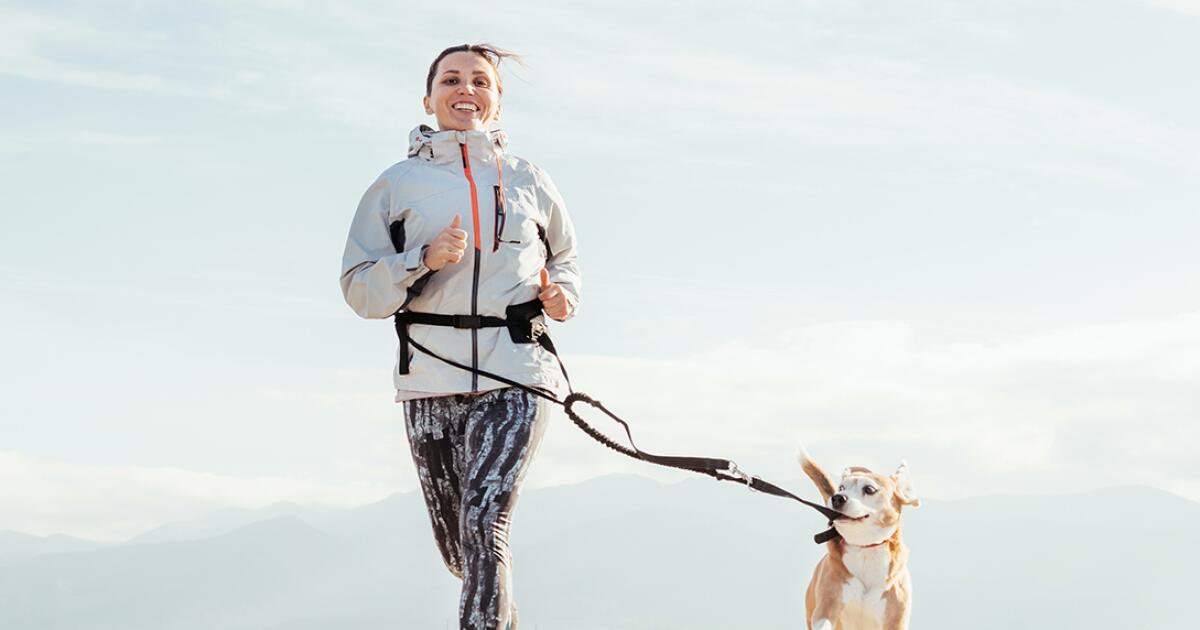
LA Times Studios may earn commission from purchases made through our links.
Introduction to Dog Running
It’s one of the simplest ways to combine fitness with spending quality time with your canine companion. But before you grab the leash and hit the pavement, it’s important to think about safety, training and the right gear. Choosing a proper dog harness and leash setup, for instance, not only protects your dog’s neck from the strain of a collar but also gives you more control. A dog’s breed, age and overall health should also be considered when you’re building a running plan.
Breeds Better Suited for Running
Now, the breeds. Not all dogs are equally well-suited for long distances. Some are built for speed or endurance, while others are better off with a short jogging session.
A “running buddy” breed typically has a lean, athletic build and good cardiovascular capacity. You’re also looking for sound joints and a nose or mouth structure that lets them breathe easily. A good temperament is also very important, of course.
Some of the best breeds of dogs to go running with are:
The German Shorthaired Pointer is a total powerhouse, known for its incredible stamina.
You’ll also see a lot of sporting and hunting breeds out there on the trail. The Vizsla, Weimaraner and Dalmatian all love a good long run.
The Rhodesian Ridgeback is a sturdy and energetic partner for the trail.
A bunch of other high-energy working dogs also make the cut. The English Springer Spaniel, Border Collie and other Pointer types are almost always an excellent choice for a running partner.
Don’t forget the Siberian Husky. Bred for pulling sleds over long distances, their endurance is next level, although they may be sensitive to hotter climates.
On the flip side, brachycephalic (that’s the flat-faced breeds) like Pugs, Bulldogs or French Bulldogs are much more prone to overheating and aren’t recommended for longer runs.
But even within a “running breed,” individual dogs will be different.
Sighthounds like Greyhounds or Whippets, for example, are incredibly fast sprinters but might not prefer a long endurance run. Before you start running, it’s a good idea to talk to a veterinarian about your particular dog.
Choosing the Right Leash
The dog leash you pick can make or break your dog running experience. Many runners feel the best dog leash is a bungee leash, which absorbs sudden pulls and reduces strain from dog pulling or jumping. A shorter leash keeps your dog closer for greater control, while a longer leash allows more freedom (a popular bungee option is the Roamer leash).
Always match the leash length to your dog’s size. And if you run in low light, reflective stitching adds an extra layer of safety.
Pre-Run Preparation
A little prep work goes a long way. A waist belt is a game-changer for hands free running. And you’ll need to carry the essentials: Poop bags, fresh water and a collapsible bowl. Pay close attention to the weather conditions, since hot pavement can burn their paws. Pausing for water breaks will keep your pet’s enthusiasm (and stamina) high.
Training Your Dog
So your dog is new to running? The trick is to start with a proper walk. Build a solid foundation by teaching good leash manners and ensuring your dog does not pull on the leash, which is essential for safe running. Then, gradually increase short running intervals, teaching your dog to maintain a consistent pace during runs.
Positive reinforcement, like praise and treats, will help your dog associate running with fun. When introducing training cues, you can teach a slowing cue in the same way as a speeding up cue. Always guide your dog to stay on one side to avoid them crossing in front of you where you might trip.
Safety Considerations
This one’s important. Running safely with your dog means protecting both you and your pup. A well-fitted dog harness is non-negotiable as it prevents neck strain and gives you more control over their body. Make sure the harness does not restrict your dog’s legs and allows for natural movement. If your dog is pulled too hard on the leash, it can cause discomfort or even injury, so always maintain a steady pace and avoid sudden tugs.
It’s imperative you keep vigilant and watch your surroundings. Look out for passing cars and wildlife that might trigger their chasing instincts. Monitor your dog’s body language too. Excessive panting or slowing down can be signs of stress or fatigue.
Health and Hygiene
When you’re hitting the pavement with your four-legged buddy, keeping both of you healthy and clean isn’t just nice to have—it’s essential. Let’s talk harnesses first: you’ll want something that fits your pup like a glove. This isn’t just about looking good (though your dog will definitely look sharp). A proper harness spreads out all that enthusiastic pulling across your dog’s chest instead of yanking on their neck, which is especially crucial if you’ve got one of those high-energy breeds like a Border Collie who thinks every run is the best thing that’s ever happened to them.
Here’s something that might not sound glamorous but trust me on this one: poop bag duty is non-negotiable. Whether you’re cruising through downtown or exploring that Instagram-worthy trail, always pack those bags and actually use them. It’s one of those simple things that keeps everyone happy—other runners, hikers, and basically anyone who doesn’t want to step in surprises. And here’s a pro tip your future self will thank you for: wash your hands thoroughly when you get back, especially after handling leashes, harnesses, or if you’ve been giving those muddy paws some attention.
Weather is a key component for your running buddy’s comfort and safety. On those scorching summer days, that pavement can turn into a literal hot plate for sensitive paw pads. If you’re someone who loves those early morning or evening runs when it’s getting dark, reflective gear and a bungee leash or Roamer leash aren’t just smart choices, they’re lifesavers.
Trail running? That’s where a longer leash can let your dog live their best explorer life, but keep your wits about you, especially somewhere new. In busy areas or anywhere with lots of traffic, shorter leashes give you that extra control to keep everyone safe.
A little secret for hands-free running enthusiasts: a waist belt with leg straps might just change your life, particularly if your dog has mastered the art of enthusiastic pulling. This setup lets you stay balanced and in control while keeping your hands free for the important stuff—water, treats, or just enjoying the run without feeling like you’re in a constant tug-of-war.
Trail Running
And for the adventurous types, there’s the trail run. A good trail runner is always prepared. Choose pet-friendly trails without steep drops and always keep your dog on a harness and leash for control. A waist belt is really helpful on uneven ground. Be mindful of the environment by cleaning up after your dog and minimizing ecological disturbance on trails. And pack extra water if you’re exploring an unfamiliar trail.



